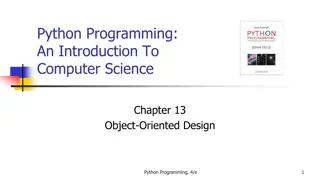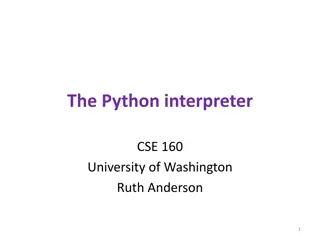Object-Oriented Python Code for WIMP Direct Detection Signals
Calculating signals for Weakly Interacting Massive Particle (WIMP) direct detection using an object-oriented Python code called WimPyDD. WimPyDD provides accurate predictions for expected rates in WIMP direct detection experiments within the framework of Galilean invariant non-relativistic effective theory. It handles different scenarios including inelastic scattering, WIMPs of arbitrary spin, and generic velocity distributions in the Galactic halo. WimPyDD has been tested extensively and applied in various Dark Matter direct detection studies.
Download Presentation

Please find below an Image/Link to download the presentation.
The content on the website is provided AS IS for your information and personal use only. It may not be sold, licensed, or shared on other websites without obtaining consent from the author.If you encounter any issues during the download, it is possible that the publisher has removed the file from their server.
You are allowed to download the files provided on this website for personal or commercial use, subject to the condition that they are used lawfully. All files are the property of their respective owners.
The content on the website is provided AS IS for your information and personal use only. It may not be sold, licensed, or shared on other websites without obtaining consent from the author.
E N D
Presentation Transcript
WimPyDD : an object-oriented Python code to calculate WIMP direct detection signals Sunghyun Kang PASCOS 2021 June 14 - 18, 2021
Basic concepts of WIMP direct detection WIMPS (Weakly Interacting Massive Particles) are the most popular Dark Matter candidates (but many other possibilities ): few GeV < WIMP mass< few TeV No electric charge, no color Weak-type interactions with ordinary matter keep WIMPS in thermal equilibrium in the early Universe and can provide the correct relic abundance through thermal decoupling ( WIMP miracle ) Direct detection In direct detection, the signals are nuclear recoil events driven by unknown new physics at expected scale > 1 TeV momentum transfer is lower, a few hundred MeV or less. NREFT provides a general and efficient way to characterize results with mass of WIMP and coupling constants nuclear response provides compact form of WIMP-nucleus cross section NREFT requires nuclear form factors and new operators new operators lead to cross section dependent on q and v 2 I. Jeong, S. Kang, S. Scopel, G. Tomar, arXiv:2106.06207
WimPyDD is an objectoriented and customizable Python code that calculates accurate predictions for the expected rates in WIMP direct detection experiments within the framework of Galilean invariant non relativistic effective theory. WimPyDD handles different scenarios including inelastic scattering, WIMP of arbitrary spin and a generic velocity distribution of WIMP in the Galactic halo. WimPyDD is written by Stefano Scopel, Gaurav Tomar, Sunghyun Kang, and Injun jeong. 3 I. Jeong, S. Kang, S. Scopel, G. Tomar, arXiv:2106.06207
Before its present release WimPyDD has been extensively tested on several publications. Among them: DAMA/LIBRA-phase2 in WIMP effective models Sunghyun Kang, Stefano Scopel, Gaurav Tomar, Jong-Hyun Yoon JCAP 07 (2018) 016 [arXiv: 1804.07528] Present and projected sensitivities of Dark Matter direct detection experiments to effective WIMP-nucleus couplings Sunghyun Kang, Stefano Scopel, Gaurav Tomar, Jong-Hyun Yoon Astropart. Phys. 109 (2019) 50-68 [arXiv: 1805.06113] Anapole Dark Matter after DAMA/LIBRA-phase2 Sunghyun Kang, Stefano Scopel, Gaurav Tomar, Jong-Hyun Yoon, Paolo Gondolo JCAP 11 (2018) 040 [arXiv: 1808.04112] On the sensitivity of present direct detection experiments to WIMP-quark and WIMP-gluon effective interactions: a systematic assessment and new model-independent approaches Sunghyun Kang, Stefano Scopel, Gaurav Tomar, Jong-Hyun Yoon Astropart. Phys. 114 (2020) 80-91 [arXiv: 1810.006007] Proton-philic spin-dependent inelastic Dark Matter (pSIDM) as a viable explanation of DAMA/LIBRA-phase2 Sunghyun Kang, Stefano Scopel, Gaurav Tomar, Jong-Hyun Yoon Phys.Rev.D 99 (2019) 2, 023017 [arXiv: 1810.09674] Probing DAMA/LIBRA in the full parameter space of WIMP effective models of inelastic scattering Sunghyun Kang, Stefano Scopel, Gaurav Tomar Phys.Rev.D 99 (2019) 10, 103019 [arXiv: 1902.09121] The effective theory of nuclear scattering for a WIMP of arbitrary spin Paolo Gondolo, Sunghyun Kang, Stefano Scopel, Gaurav Tomar [arXiv: 2008.05120] The phenomenology of nuclear scattering for a WIMP of arbitrary spin, Paolo Gondolo, Injun jeong, Sunghyun Kang, Stefano Scopel, Gaurav Tomar [arXiv: 2102.09778] 4 I. Jeong, S. Kang, S. Scopel, G. Tomar, arXiv:2106.06207
WimPyDD introduction Main features of WimPyDD: object-oriented customizable portable (Python) What WimPyDD can do: calculates accurate predictions for the expected rates in WIMP direct detection experiments in virtually any scenario: Galilean-invariant non-relativistic effective theory an arbitrary WIMP spin inelastic scattering generic WIMP velocity distribution in the Galactic halo including the detector s response How WimPyDD does it: calculates the three main components that enter the calculation of direct detection signals: the Wilson coefficients of the effective theory the detector response functions (containing acceptance, energy resolution, response to nuclear recoils, binning, etc) the halo function and stores them for later interpolation, using a parameterization that does not depend on the WIMP mass Transparent and fast, suitable for WIMP parameter space of large dimensionality 5 I. Jeong, S. Kang, S. Scopel, G. Tomar, arXiv:2106.06207
WimPyDD introduction WimPyDD provides three routines to calculate expected signals: 6 I. Jeong, S. Kang, S. Scopel, G. Tomar, arXiv:2106.06207
How to install 1) https://wimpydd.hepforge.org/ Download and unpack zip file in working directory or git clone https://phab.hepforge.org/source/WimPyDD.git 2) >>>import WimPyDD as WD all libraries are standard 3) to test the installation, we provide a Python code : test_WimPyDD_installation.py which automatically executes simple calculations and produces some plots 7 I. Jeong, S. Kang, S. Scopel, G. Tomar, arXiv:2106.06207
WimPyDD introduction WimPyDD provides three routines to calculate expected signals: 1) WD.dsigma_der(element,hamiltonian,mchi,v,er,**args) that calculates the differential cross section on target (in cm/keV) 2) WD.diff_rate(target,hamiltonian,mchi, energy,vmin,delta_eta,**arg) that calculates the differential rate (in events/keV) without including the response of the detector. 3) WD.wimp_dd_rate(exp,hamiltonian,vmin,delta_eta,mchi,**args) that calculates the integrated expected rates including the response of the detector 4 input classes: 1) element: extendable (pre-defined: WD.Al WD.Ar WD.C WD.Ca WD.F WD.Fe WD.Ge WD.H WD.He WD.I,WD.Mg WD.N WD.Na WD.Ne WD.Ni WD.O WD.S WD.Si WD.W WD.Xe ) 2) target: a single element or linear combination of elements with stoichiometric coefficients 3) eft_hamiltonian: set up effective Hamiltonian with arbitrary combination of operators and Wilson coefficients Two operator bases available: Anand et al. arXiv:1308.6288 (spin=0,1/2), Gondolo et al., arXiv:2008.05120 (any WIMP spin) 4) experiment: experimental set-up information 8 I. Jeong, S. Kang, S. Scopel, G. Tomar, arXiv:2106.06207
EXAMPLE1 Differential rate on sodium iodine for Hamiltonian: 9 I. Jeong, S. Kang, S. Scopel, G. Tomar, arXiv:2106.06207
EXAMPLE1 the differential rate of DAMA-LIBRA in standard spin independent case 1)Set-up Hamiltonian (use eft_hamiltonian class) : Dictionary with operators and Wilson coefficients To choose operator O1. Onwith n=1,3, ,15 available Wilson coefficient - function of arbitrary parameters, including transferred momentum (ex: propagator) WimPyDD Hamiltonian object 10 I. Jeong, S. Kang, S. Scopel, G. Tomar, arXiv:2106.06207
Two operator bases available in WimPyDD: X=nucleon current(?, , , , ) s=number of WIMP spin operators l=power of the momentum exchange vectors valid for arbitrary spins. P. Gondolo, I. Jeong, S. Kang, S. Scopel, G. Tomar arXiv: 2008.05120 11 I. Jeong, S. Kang, S. Scopel, G. Tomar, arXiv:2106.06207
EXAMPLE1 2) Halo function (use streamed_halo_function routine) : Array containing velocities and halo function: Default: Maxwellian with standard choice of the parameters NB: the streamed_halo_function routine works also for a generic velocity distribution 12 I. Jeong, S. Kang, S. Scopel, G. Tomar, arXiv:2106.06207
EXAMPLE1 3) Set up target (to include quenching, needs to be an attribute of an experiment object) : In this way, nai is an attribute of dama and has dama quenching factors (quenching included) For instance, to use different quenching for COSINE use nai=COSINE.target (quenching NOT included) To get compound just take linear combination! another example: C3F8 c3f8=3*WD.C + 8*WD.F 13 I. Jeong, S. Kang, S. Scopel, G. Tomar, arXiv:2106.06207
EXAMPLE1 4) result (use diff_rate routine) : Hamiltonian parameters passed as keyworded variable-length argument list No binning, no detector response How to include them? 14 I. Jeong, S. Kang, S. Scopel, G. Tomar, arXiv:2106.06207
EXAMPLE2 Binned rate on sodium iodine (DAMA-LIBRA) for same Hamiltonian including detector s response: 15 I. Jeong, S. Kang, S. Scopel, G. Tomar, arXiv:2106.06207
EXAMPLE2 1) Set up DAMA-Libra detector (use experiment class) : Name of directory WimPyDD/Experiments/dama/ containing detector information Energy resolution Energy binning Format: Python function or table to interpolate exposure Quenching for Iodine Quenching for Sodium target information(NaI) 16 I. Jeong, S. Kang, S. Scopel, G. Tomar, arXiv:2106.06207
EXAMPLE2 2) Load response functions: Rate requires double integral slow WD.load_response_functions performs calculation(independent on WIMP mass) only at first call. Later calls load pre-calculated response functions fast! 3) Call wimp_dd_rate routine: Hamiltonian parameters passed as keyworded variable-length argument list Binning + detector response 17 I. Jeong, S. Kang, S. Scopel, G. Tomar, arXiv:2106.06207
EXAMPLE3 Yearly modulation in DAMA-Libra for Hamiltonian O9 1) Set up Hamiltonian (use eft_hamiltonian class) : Returns Wilson coeffi cients in GeV-2as a function of WIMP mass, effective cross section and r=cn/cp For O9 18 I. Jeong, S. Kang, S. Scopel, G. Tomar, arXiv:2106.06207
EXAMPLE3 2) Halo function for yearly modulation (use streamed_halo_halo_function routine) : To get halo function for yearly modulation 3) Load response functions: 19 I. Jeong, S. Kang, S. Scopel, G. Tomar, arXiv:2106.06207
EXAMPLE3 4) Call wimp_dd_rate routine: Hamiltonian parameters passed as keyworded variable-length argument list S. Kang, S. Scopel, G. Tomar, J.H. Yoon, JCAP07(2018)016 20 I. Jeong, S. Kang, S. Scopel, G. Tomar, arXiv:2106.06207
EXAMPLE4 More complicated Hamiltonian for O4&O5&O6 of DAMA-Libra 1) Set up Hamiltonian (use eft_hamiltonian class): 21 I. Jeong, S. Kang, S. Scopel, G. Tomar, arXiv:2106.06207
EXAMPLE4 2) Set up keyword arguments: 3) Call wimp_dd_rate routine: c_456 Hamiltonian parameters passed as keyworded variable-length argument list S. Kang, S. Scopel, G. Tomar, PRD(2019)1030190 22 I. Jeong, S. Kang, S. Scopel, G. Tomar, arXiv:2106.06207
EXAMPLE5 WimPyDD provides the routine WD.mchi_vs_exclusion to calculate exclusion plots for instance, for a standard spin independent interaction and XENON1T detector 1) Set up Hamiltonian (use eft_hamiltonian class): 2) Set up XENON1T detector (use experiment class) : 3) Call mchi_vs_exclusion routine: 23 I. Jeong, S. Kang, S. Scopel, G. Tomar, arXiv:2106.06207
https://wimpydd.hepforge.org/ No time to explain all 1) implement new targets 2) use custom nuclear response functions default choice from Anand et. al [1308.6288] and R. Catena and B. Schwabe [1501.03729] 3) arbitrary velocity distribution 4) use modifier to allow for additional effects 5) estimating the upper bound on any parameter using mchi_vs_exclusion routine visit homepage for more details! ! ! ! Have fun with 24 I. Jeong, S. Kang, S. Scopel, G. Tomar, arXiv:2106.06207























